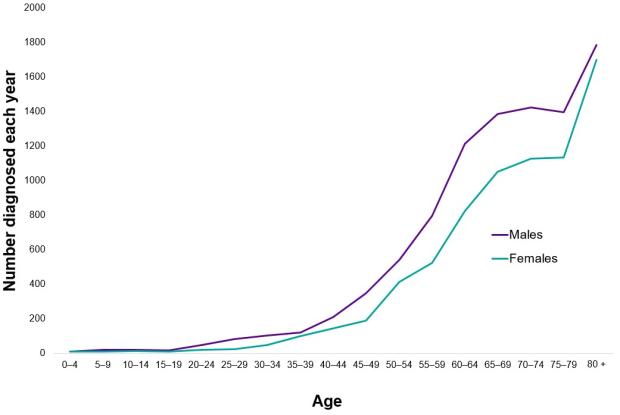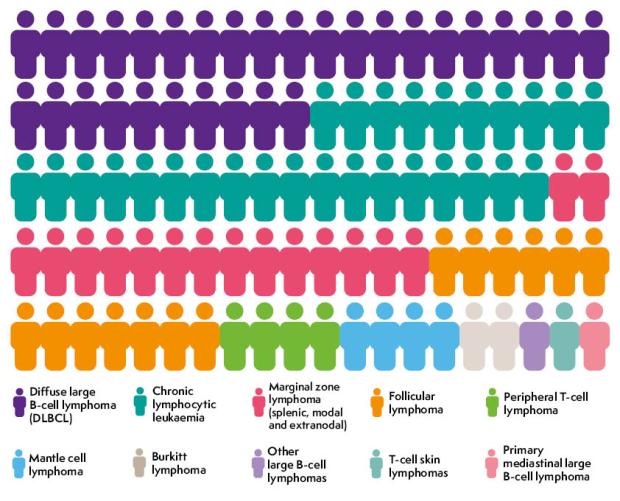Non-Hodgkin lymphoma
This information gives you an overview of non-Hodgkin lymphoma. We have separate information pages with more detailed information on the most common types of non-Hodgkin lymphoma.
On this page
Who gets non-Hodgkin lymphoma?
- High-grade non-Hodgkin lymphoma
- Low-grade non-Hodgkin lymphoma
What is non-Hodgkin lymphoma?
Lymphoma is a type of blood cancer that develops when white blood cells called lymphocytes grow out of control. Lymphocytes are part of your immune system. They travel around your body in your lymphatic system, helping you fight infections.
Lymphomas can be grouped into Hodgkin lymphomas or non-Hodgkin lymphomas, depending on what the lymphoma cells look like when doctors examine them under a microscope.
- Hodgkin lymphoma contains abnormal cells called Reed–Sternberg cells.
- Non-Hodgkin lymphoma is any type of lymphoma that is not Hodgkin lymphoma.
We have separate information on possible causes and symptoms of lymphoma.
Who gets non-Hodgkin lymphoma?
Around 14,200 people are diagnosed with non-Hodgkin lymphoma each year in the UK. On top of this, around 3,800 people a year are diagnosed with chronic lymphocytic leukaemia (CLL), which is sometimes considered a form of non-Hodgkin lymphoma. This means almost 50 people are diagnosed with non-Hodgkin lymphoma or CLL every day in the UK.

Non-Hodgkin lymphoma can affect people of any age, but it is much more common in older people. Most people diagnosed are over 55. However, some types of non-Hodgkin lymphoma can affect children. We have separate information on lymphoma in children (aged 0 to 15) and lymphoma in young people (aged 16 to 24) where you can find out more.
Non-Hodgkin lymphoma affects slightly more males than females. It can develop in people of any ethnic background.
If you are worried that you might have symptoms of lymphoma, or have any concerns about your health, contact your GP.
Types of non-Hodgkin lymphoma
There are over 60 different types of non-Hodgkin lymphoma. Some of them are very rare.
Different types of non-Hodgkin lymphoma are often grouped together depending on how they develop or how they behave. The two main ways to sort non-Hodgkin lymphoma are:
- How fast-growing they are: Some types of non-Hodgkin lymphoma grow slowly (low-grade lymphomas). Others grow at a faster rate (high-grade lymphomas). Sometimes a lymphoma changes from a slow-growing type into a faster-growing type. This is known as ‘transformation’.
- The type of lymphocyte they developed from: Non-Hodgkin lymphoma can develop from B cells (B-cell lymphoma) or T cells (T-cell lymphoma). Most non-Hodgkin lymphomas develop from B cell lymphomas. Only around 1 in 10 develop from T cells. Most T-cell lymphomas are high-grade. B-cell lymphomas can be high-grade or low-grade.
High-grade non-Hodgkin lymphoma
Some types of non-Hodgkin lymphoma grow faster than others. Non-Hodgkin lymphoma is called ‘high grade’ when the lymphoma cells are dividing quickly. Specialists can see this when they look at the cells under a microscope.
High-grade non-Hodgkin lymphoma is sometimes called ‘aggressive’ lymphoma. Although this might sound alarming, high-grade non-Hodgkin lymphoma usually responds very well to treatment. Most types of high-grade non-Hodgkin lymphoma are unlikely to come back after successful treatment.
There are many different types of high-grade non-Hodgkin lymphoma. They can develop from B cells or T cells.
We have an animation about Hodgkin and high-grade non-Hodgkin lymphoma that you might find helpful. It is designed to help parents and carers who have lymphoma talk to their children about it.
Dr Adam Gibb gives an overview of high-grade lymphomas, covering what they are, their diagnosis and their treatment. You might also find our video of Professor John Radford gives an update on the new and future treatments for high-grade non-Hodgkin lymphoma helpful.
Low-grade non-Hodgkin lymphoma
Non-Hodgkin lymphoma is called ‘low grade’ or ‘indolent’ when the lymphoma cells are dividing slowly.
Watch Professor Simon Rule explain low-grade non-Hodgkin lymphoma and hear Maureen share her experience of being diagnosed with follicular lymphoma, a type of low-grade non-Hodgkin lymphoma
Low-grade lymphomas generally respond well to treatment but they are hard to get rid of completely. They are usually treated with the aim of controlling the lymphoma rather than curing it. Low-grade non-Hodgkin lymphomas can often be controlled for many years. People might go for long periods when they feel well and don’t need treatment. Over time, though, low-grade non-Hodgkin lymphomas usually come back and need more treatment. Most people have several different treatments over the course of their illness. It helps some people to think of low-grade non-Hodgkin lymphoma as a long-term (chronic) illness that needs treatment from time-to-time.
There are many different types of low-grade non-Hodgkin lymphoma. Most types of low-grade non-Hodgkin lymphoma develop from B cells but some low-grade skin lymphomas develop from T cells.
We have an animation about low-grade non-Hodgkin lymphoma that you might find helpful. It is designed to help parents and carers who have lymphoma talk to their children about it.
Dr Rob Lown gives an overview of low-grade lymphomas, covering what they are, their diagnosis and their treatment. You might also find our video of Professor John Radford gives an update on the new and future treatments for low-grade non-Hodgkin lymphoma helpful.
List of non-Hodgkin lymphoma types
Here, we list the most common types of non-Hodgkin lymphoma by how fast they are growing and the type of lymphocyte they develop from. We have separate information on these types.
High-grade B-cell non-Hodgkin lymphomas
- Diffuse large B-cell lymphoma (DLBCL) and other large B-cell lymphomas such as:
- Burkitt lymphoma
- Primary central nervous system lymphoma (primary CNS lymphoma)
High-grade T-cell non-Hodgkin lymphomas
- Anaplastic large cell lymphoma (ALCL)
- Angioimmunoblastic T-cell lymphoma (AITL)
- Enteropathy-associated T-cell lymphoma (EATL)
- Adult T-cell leukaemia/lymphoma (ATL)
- Extranodal NK/T-cell lymphoma (nasal-type)
- Hepatosplenic T-cell lymphoma
- Peripheral T-cell lymphoma not otherwise specified (PTCL-NOS)
- Sézary syndrome
Lymphoblastic lymphoma is a rare form of high-grade non-Hodgkin lymphoma that develops from immature lymphocytes. It can develop from B cells or T cells. It typically affects younger people. It is very similar to acute lymphoblastic leukaemia (ALL) and is treated in the same way. Leukaemia Care provides more detailed information about ALL.
Low-grade B-cell non-Hodgkin lymphomas
- Follicular lymphoma (usually low-grade, although grade 3B follicular lymphoma can behave, and is treated, more like a high-grade lymphoma)
- Mantle cell lymphoma (although this sometimes behaves more like a high-grade lymphoma)
- Chronic lymphocytic leukaemia (CLL)/small lymphocytic lymphoma (SLL)
- Lymphoplasmacytic lymphoma (Waldenström’s macroglobulinaemia)
- Marginal zone lymphomas:
- Extranodal marginal zone lymphoma (also called MALT lymphoma)
- Nodal marginal zone lymphoma
- Splenic marginal zone lymphoma
- Primary cutaneous follicle centre lymphoma
Low-grade T-cell non-Hodgkin lymphomas
Most skin lymphomas are low-grade T-cell lymphomas. They include:
- Mycosis fungoides
- Primary cutaneous CD30-positive lymphoproliferative disorders, such as primary cutaneous anaplastic large-cell lymphoma and lymphomatoid papulosis
- Rarer types of T-cell skin lymphoma
If you have a type of non-Hodgkin lymphoma that we do not mention, please contact our Helpline on 0808 808 5555 or via Live Chat. They will help you find information most suitable to your needs.
How common is each type of non-Hodgkin lymphoma?
Some types of non-Hodgkin lymphoma are very rare. Others are more common.

In adults, the most common types of non-Hodgkin lymphoma are:
- diffuse large B-cell lymphoma (DLBCL)
- chronic lymphocytic leukaemia (this is not technically a non-Hodgkin lymphoma but it behaves in a similar way)
- marginal zone lymphomas (nodal marginal zone lymphoma, extranodal marginal zone lymphoma and splenic marginal zone lymphoma)
- follicular lymphoma.
In children and young people, the most common types of non-Hodgkin lymphoma are:
